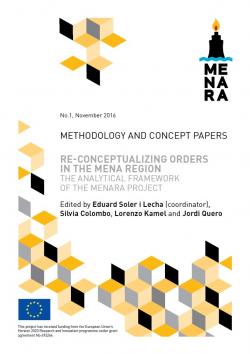Re-conceptualizing Orders in the MENA Region. The Analytical Framework of the MENARA Project
Definire l’architettura concettuale per il progetto MENARA è lo scopo di questo lavoro, che si articola in cinque sezioni tematiche. La prima ricostruisce le principali congiunture storiche in cui i poteri chiave hanno dato forma alle caratteristiche che definiscono l’attuale regione del Medio Oriente e Nord Africa. La seconda sezione delinea la portata geografica del progetto, fa una mappatura della distribuzione del potere e definisce il sistema regionale e le sue principali caratteristiche. La terza sezione si concentra sugli ordinamenti interni in una regione in via di trasformazione, misurando e ripercorrendo l’evoluzione di quattro tendenze, ossia l’erosione delle capacità delgli Stati; la securitizzazione delle politiche dei regimi; la militarizzazione dei conflitti; e la pluralizzazione delle identità collettive. La quarta sezione collega gli sviluppi del sistema globale al loro impatto nella regione in termini di potere, idee, norme e identità. L’ultima sezione si concentra sugli studi previsionali e propone una metodologia per poter fare una proiezione delle tendenze e costruire degli scenari. Tutte le sezioni, così come la conclusione, formulano specifiche domande di ricerca che possono aiutare a comprendere il sistema geopolitico che si sta delineando in Medio Oriente e Nord Africa.
-
Dati bibliografici
Roma, IAI, novembre 2016, 114 p. -
In:
-
Numero
Methodology and Concept Papers 1
Introduction, Lorenzo Kamel and Eduard Soler i Lecha
1. The Past: Terminology, Concepts and Historical Junctures, Lorenzo Kamel, Karim Makdisi and Waleed Hazbun
1.1 Deconstructing Concepts and Terminology
1.2 Orders and Borders: Imperial Legacies
Geopolitical Dynamics
A New Order in the Making
A North-African Perspective
The First World War and the Mandates System
The Interwar Period
The Second World War, Oil, and the Decline of European Hegemony
1.3 The Dynamics of, and Struggle over, the Contemporary Regional Order: Turning Points
Arab Nationalism and Egypt’s Effort to Order the Region, 1950s-60s
State Power and Geopolitical Rivalries, 1970s-80s
The Rise and Decline of the American Era, 1990s-2000s
1.4 Legacies of the Past and the Future of Regional Order
Research Questions
References
2. The Contemporary Regional Order, Helle Malmvig, Jordi Quero and Eduard Soler i Lecha
2.1 The Region
What Is a Region? Understanding a Challenging Notion
The Middle East and North Africa: Setting the Project’s Geographical Scope
2.2 Regional Powers
The Distribution of Power: The Evolution of the Structure of the MENA Sub-System
2.3 Regional Order
Approximations of the Concept of Regional Order
The Institutions of the Regional Order in the MENA Sub-System
2.4 An Integrated Region? Regional Cooperation Initiatives
2.5 A Fragmented Region? Amity and Enmity Patterns
Challenges to Regimes and State Orders and the Rise of Identity Politics
2.6 The MENA Region in Relation to the Global Order: Just a Passive Periphery?
Research Questions
References
3. Domestic Orders, Rasmus Alenius Boserup
Introduction
3.1 Erosion of State Capacities
3.2 Securitization of Regime Policies
3.3 Militarization of Contentious Politics
3.4 Pluralization of Collective Identities
3.5 Conceptualizing Domestic Orders
Research Questions
References
4. Global Dynamics in the MENA Region, Pol Morillas, Erzsébet N. Rózsa and Máté Szalai
Introduction
4.1 The Rivalry of State Actors and the Global Shift of Power
4.2 The Role of Non-State Actors in the Dynamics between the Regional and Global Orders
4.3 Ideas, Norms and Identities
Research Questions
References
5. The Future. Foresight Studies on the Middle East and North Africa, Edgar Göll
5.1 The Conceptual Architecture of Future Studies
5.2 Taking Stock of Existing Foresight Studies on the MENA Region
Arab Futures. Three Scenarios for 2025
Interpretation of the Foresight Report “Migration and Global Environmental Change” for the Middle East and North Africa (until 2011)
Addressing Agricultural Import Dependence in the Middle East-North Africa Region Through the Year 2050
5.3 Imagining Futures for the MENARA Project
Research Questions
References
Conclusions, Silvia Colombo and Jordi Quero
Annex: The MENARA Project: The 50 Concepts
Abbreviations




